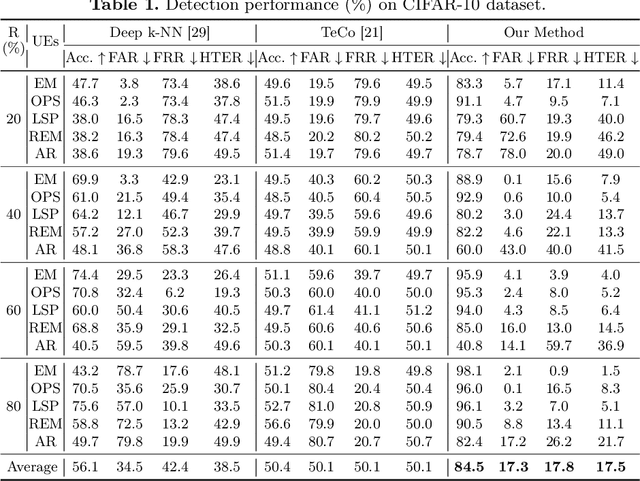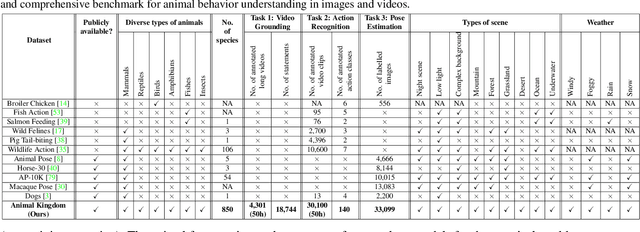Qichen Zheng
Towards Physical World Backdoor Attacks against Skeleton Action Recognition
Aug 16, 2024Abstract:Skeleton Action Recognition (SAR) has attracted significant interest for its efficient representation of the human skeletal structure. Despite its advancements, recent studies have raised security concerns in SAR models, particularly their vulnerability to adversarial attacks. However, such strategies are limited to digital scenarios and ineffective in physical attacks, limiting their real-world applicability. To investigate the vulnerabilities of SAR in the physical world, we introduce the Physical Skeleton Backdoor Attacks (PSBA), the first exploration of physical backdoor attacks against SAR. Considering the practicalities of physical execution, we introduce a novel trigger implantation method that integrates infrequent and imperceivable actions as triggers into the original skeleton data. By incorporating a minimal amount of this manipulated data into the training set, PSBA enables the system misclassify any skeleton sequences into the target class when the trigger action is present. We examine the resilience of PSBA in both poisoned and clean-label scenarios, demonstrating its efficacy across a range of datasets, poisoning ratios, and model architectures. Additionally, we introduce a trigger-enhancing strategy to strengthen attack performance in the clean label setting. The robustness of PSBA is tested against three distinct backdoor defenses, and the stealthiness of PSBA is evaluated using two quantitative metrics. Furthermore, by employing a Kinect V2 camera, we compile a dataset of human actions from the real world to mimic physical attack situations, with our findings confirming the effectiveness of our proposed attacks. Our project website can be found at https://qichenzheng.github.io/psba-website.
Unlearnable Examples Detection via Iterative Filtering
Aug 15, 2024



Abstract:Deep neural networks are proven to be vulnerable to data poisoning attacks. Recently, a specific type of data poisoning attack known as availability attacks has led to the failure of data utilization for model learning by adding imperceptible perturbations to images. Consequently, it is quite beneficial and challenging to detect poisoned samples, also known as Unlearnable Examples (UEs), from a mixed dataset. In response, we propose an Iterative Filtering approach for UEs identification. This method leverages the distinction between the inherent semantic mapping rules and shortcuts, without the need for any additional information. We verify that when training a classifier on a mixed dataset containing both UEs and clean data, the model tends to quickly adapt to the UEs compared to the clean data. Due to the accuracy gaps between training with clean/poisoned samples, we employ a model to misclassify clean samples while correctly identifying the poisoned ones. The incorporation of additional classes and iterative refinement enhances the model's ability to differentiate between clean and poisoned samples. Extensive experiments demonstrate the superiority of our method over state-of-the-art detection approaches across various attacks, datasets, and poison ratios, significantly reducing the Half Total Error Rate (HTER) compared to existing methods.
GradMDM: Adversarial Attack on Dynamic Networks
Apr 01, 2023Abstract:Dynamic neural networks can greatly reduce computation redundancy without compromising accuracy by adapting their structures based on the input. In this paper, we explore the robustness of dynamic neural networks against energy-oriented attacks targeted at reducing their efficiency. Specifically, we attack dynamic models with our novel algorithm GradMDM. GradMDM is a technique that adjusts the direction and the magnitude of the gradients to effectively find a small perturbation for each input, that will activate more computational units of dynamic models during inference. We evaluate GradMDM on multiple datasets and dynamic models, where it outperforms previous energy-oriented attack techniques, significantly increasing computation complexity while reducing the perceptibility of the perturbations.
Animal Kingdom: A Large and Diverse Dataset for Animal Behavior Understanding
Apr 18, 2022
Abstract:Understanding animals' behaviors is significant for a wide range of applications. However, existing animal behavior datasets have limitations in multiple aspects, including limited numbers of animal classes, data samples and provided tasks, and also limited variations in environmental conditions and viewpoints. To address these limitations, we create a large and diverse dataset, Animal Kingdom, that provides multiple annotated tasks to enable a more thorough understanding of natural animal behaviors. The wild animal footages used in our dataset record different times of the day in extensive range of environments containing variations in backgrounds, viewpoints, illumination and weather conditions. More specifically, our dataset contains 50 hours of annotated videos to localize relevant animal behavior segments in long videos for the video grounding task, 30K video sequences for the fine-grained multi-label action recognition task, and 33K frames for the pose estimation task, which correspond to a diverse range of animals with 850 species across 6 major animal classes. Such a challenging and comprehensive dataset shall be able to facilitate the community to develop, adapt, and evaluate various types of advanced methods for animal behavior analysis. Moreover, we propose a Collaborative Action Recognition (CARe) model that learns general and specific features for action recognition with unseen new animals. This method achieves promising performance in our experiments. Our dataset can be found at https://sutdcv.github.io/Animal-Kingdom.
 Add to Chrome
Add to Chrome Add to Firefox
Add to Firefox Add to Edge
Add to Edge